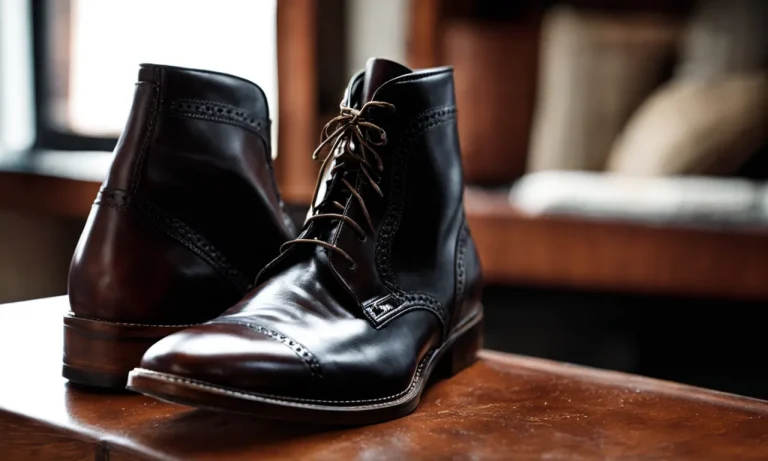If you look down at your shoes and notice a small tear or hole starting to form in the mesh upper, don’t worry – it can be fixed! Mesh shoe uppers are prone to developing small holes and tears over time from normal wear and tear.
Luckily, repairing holes in shoe mesh is an easy task anyone can tackle at home with just a few supplies.
Here is a quick 2-minute fix if you’re short on time: Clean the area around the hole, apply a small amount of shoe glue or clear nail polish into and around the hole, let dry completely, then apply 1-2 more thin layers to fully seal the mesh.
This temporary fix should hold up decently until you have time for a more thorough repair.
In this comprehensive guide, you’ll learn several effective methods for repairing holes, tears, and worn spots in the mesh fabric upper of athletic shoes and sneakers. We’ll cover both temporary quick fixes as well as more advanced and durable repair solutions using household items you likely already have on hand.
Assess the Hole and Determine the Best Fix
When faced with a hole in your shoe mesh, it is essential to assess the damage before proceeding with any repairs. By evaluating the size and location of the hole, you can determine the most suitable fix.
Check size and location of hole
The first step in assessing the hole is to determine its size. Is it a small tear or a larger, more significant hole? Small tears can often be fixed with simple DIY methods, while larger holes may require more advanced repair techniques.
Additionally, consider the location of the hole—some areas of the mesh may be subjected to more stress and strain, requiring a different approach to ensure a lasting fix.
Identify cause and fiber type
Understanding the cause of the hole is crucial in finding the best solution. Was it caused by wear and tear, or was it a result of a specific incident or accident? Knowing the cause can help prevent future damage. Additionally, identify the type of fiber used in the mesh.
Different materials may require different repair methods and materials, so it’s important to know what you’re working with.
Choose quick fix vs advanced repair
Once you have assessed the hole and determined the cause and fiber type, you can decide whether a quick fix or an advanced repair is the best option. For small tears or minor damage, a quick fix may suffice. This could involve using adhesive or a patch to cover the hole temporarily.
On the other hand, larger holes or more extensive damage may require an advanced repair, such as sewing or replacing the mesh entirely. Consider your skill level, the time you are willing to invest, and the desired outcome when choosing between the two options.
Remember, addressing holes in your shoe mesh promptly can prevent further damage and extend the lifespan of your footwear. If you are unsure about the best approach for repairing your specific shoe, it is always a good idea to consult a professional or seek advice from trusted sources like www.shoerepair.org.
Clean and Prepare the Damaged Area
Remove laces and insert shoe tree
Before you begin cleaning the damaged area of your shoe mesh, it’s important to remove the laces and insert a shoe tree. Removing the laces will give you better access to the damaged area, allowing you to clean it more effectively.
Inserting a shoe tree will help maintain the shape of the shoe and make it easier to work on.
Gently scrub with soap and water
Once the laces are removed and the shoe tree is inserted, it’s time to clean the damaged area. Start by gently scrubbing the mesh with a mixture of mild soap and water. This will help remove any dirt, grime, or stains that may be present. Use a soft brush or sponge to avoid damaging the mesh further.
Be sure to scrub in a circular motion to effectively clean the entire area.
Let shoe fully air dry
After cleaning the damaged area, it’s important to let the shoe fully air dry before moving on to the next step. This will ensure that the mesh is completely dry and ready for repair. Place the shoe in a well-ventilated area and allow it to air dry naturally.
Avoid using heat sources like hairdryers or heaters, as they can cause the mesh to shrink or warp.
Cleaning and preparing the damaged area of your shoe mesh is an important first step in fixing holes. By following these steps, you’ll be well on your way to restoring your shoes to their former glory.
Temporary Quick Fixes for On-the-Go
When you’re out and about and notice a hole in your shoe mesh, you may not have the time or resources for a permanent fix. Fortunately, there are a few temporary solutions that can help you get through the day without further damaging your shoes.
Clear nail polish or super glue
If the hole in your shoe mesh is small, using clear nail polish or super glue can provide a quick fix. Simply apply a thin layer of nail polish or a small amount of super glue over the hole and let it dry.
This will help prevent the hole from getting bigger and keep your shoe intact for the time being. Just keep in mind that this is not a long-term solution and may need to be reapplied periodically.
Shoe glue or rubber cement
If the hole in your shoe mesh is larger or more noticeable, you may need a stronger adhesive. Shoe glue or rubber cement can be used to patch up the hole and provide a more secure fix. Apply the glue or cement to both sides of the hole and press them together firmly.
Allow it to dry completely before wearing the shoes again. It’s important to note that this fix may not be as durable as a professional repair, but it can hold up for a short period of time.
Duct tape or masking tape
If you’re in a pinch and don’t have any adhesive on hand, duct tape or masking tape can be used as a temporary fix. Cut a small piece of tape and place it over the hole, smoothing it down to ensure it sticks securely.
While this may not be the most aesthetically pleasing solution, it can provide a quick fix until you have the opportunity to properly repair your shoe mesh.
Remember, these are temporary fixes and should not be relied upon for long-term use. It’s always best to properly repair your shoe mesh or consult a professional if the damage is significant. Additionally, be cautious when applying any adhesive or tape to your shoes to avoid causing further damage.
Advanced Repair Solutions for Long-Lasting Fixes
Iron-on mesh patch
If you’re looking for a quick and efficient way to fix holes in your shoe mesh, an iron-on mesh patch can be a great solution. These patches are specially designed to adhere to the mesh fabric of your shoes and provide a strong and durable fix.
To use an iron-on mesh patch, simply cut the patch to the desired size and shape, place it over the hole, and apply heat with an iron. The heat will activate the adhesive on the patch, bonding it to the mesh and creating a seamless repair.
This method is ideal for small to medium-sized holes and can be done in just a few minutes.
Needle and thread weaving method
For a more traditional approach to repairing shoe mesh, the needle and thread weaving method can be an effective solution. This method involves using a needle and thread to weave through the surrounding mesh fabric, creating a tight and secure repair.
To begin, thread a needle with a sturdy thread that matches the color of your shoe mesh. Then, carefully weave the needle and thread through the mesh, stitching in a zigzag pattern to create a strong bond.
This method requires some skill and patience, but it can provide a long-lasting fix for larger holes or areas of damage.
Mesh screen repair patch kit
If you’re looking for a comprehensive solution to repair multiple holes or areas of damage in your shoe mesh, a mesh screen repair patch kit can be a great investment. These kits typically include a variety of mesh patches in different sizes and colors, as well as adhesive and tools for application.
With a mesh screen repair patch kit, you have the flexibility to choose the right size and color patch for each hole, ensuring a seamless and professional-looking repair. These kits are widely available online and can be a cost-effective solution for repairing shoe mesh.
When it comes to fixing holes in your shoe mesh, it’s important to choose a repair method that suits the size and severity of the damage. Whether you opt for an iron-on mesh patch, the needle and thread weaving method, or a mesh screen repair patch kit, taking the time to properly repair your shoe mesh can extend the lifespan of your shoes and save you money in the long run.
Preventing Future Holes and Tears
Once you have fixed the holes in your shoe mesh, it is important to take preventive measures to avoid future damage. Here are some effective ways to prevent holes and tears from occurring again:
Avoid over-wearing shoes
One of the main reasons for holes in shoe mesh is excessive wear and tear. Wearing your shoes for extended periods without giving them a break can put strain on the mesh fabric, leading to holes. To prevent this, make sure to rotate your shoes regularly and avoid wearing the same pair every day.
This will give the mesh time to recover and reduce the chances of it getting worn out quickly.
Apply sealant spray
Using a sealant spray on your shoe mesh can provide an extra layer of protection against tears and holes. These sprays create a waterproof barrier that helps repel water, dirt, and other elements that can cause damage to the mesh fabric.
It is recommended to apply the sealant spray before wearing your shoes for the first time and reapply it periodically to maintain its effectiveness.
Patch early signs of wear
Another effective way to prevent holes in your shoe mesh is to address any signs of wear or damage as soon as you notice them. Small tears or loose threads can quickly turn into larger holes if left untreated.
Use a patch or adhesive specifically designed for shoe repair to reinforce weak areas or cover small tears. By taking action early, you can extend the lifespan of your shoes and prevent further damage.
Remember, prevention is key when it comes to maintaining the integrity of your shoe mesh. By following these tips and taking good care of your shoes, you can keep them in great condition for longer.
Conclusion
With the right materials and techniques, repairing holes, tears or worn spots in your shoe mesh can be simple and effective. Start by assessing the damage and choosing either a quick temporary fix for on-the-go repairs, or more advanced solutions for durable long term repairs.
Properly preparing the area and following the repair steps outlined above will have your shoes looking great in no time. Just be sure to let all adhesives fully cure before wearing, and take preventative steps like rotating shoes and applying sealants to avoid future holes.






